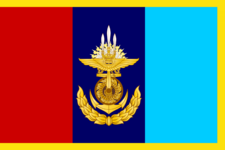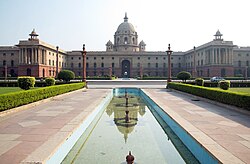Armed Forces of Rajyaghar
| Armed Forces of Rajyaghar | |
|---|---|
| His Majesty's Armed Forces | |
 Badge | |
 Flag | |
| Motto | "Jai Maharaja" (Hail to the King) |
| Founded | 1946 |
| Service branches |
|
| Headquarters | Military Joint Headquarters, Kinadica |
| Leadership | |
| Monarch | |
| Defence Secretary | |
| Chief of the Defence Staff | |
| Personnel | |
| Military age | 18-45 (55 for officers) |
| Conscription | 1 year in regular service, 3 years in the reserves Or 24 months in public service |
| Active personnel | 452,801 |
| Reserve personnel | 1,137,606 |
| Expenditure | |
| Budget | $15.3 billion |
| Percent of GDP | 3.2% |
| Related articles | |
| History | First Satrian War Second Satrian War Third Satrian War |
| Ranks | Ranks of HM Armed Forces |
The Rajyani Armed Forces, officially called His Majesty's Armed Forces, are the military forces responsible for the defence of the Kingdom of Rajyaghar and exercise of the defence policy of the Central Union Government, including the promotion of Rajyani interests, supporting bilateral and multilateral operations and providing humanitarian aid.
The forces consist of three professional uniformed services: the Grand Army, the Royal Navy, and Royal Air Force. There are also numerous special services of the military which have unique and distinct mission objectives. The Royal Navy operates the specialised "Sarisra Squadron" which is a dedicated group of river ships tasked with patrolling the major rivers of Rajyaghar to prevent against smuggling and other illegal activities. The Grand Army maintains the "Marine Commando Group" (MCG), an elite corps within the army which is often tasked with conducting the most difficult of operations. The Royal Air Force operates the "Specialist Paratrooper Service" (SPS) which often works alongside the MCG in difficult operations.
The Monarch of Rajyaghar is the Supreme Commander in Chief of the armed forces, however, executive management of the armed forces is conducted on the Monarch's behalf by the Secretary of State for Defence, who leads the Ministry of Defence, with advice from the Premier and National Security Council. With a strength of over 450 thousand active personnel and a reserve force over 1.3 million, the Rajyani armed forces is one of the largest in Satria. The military budget is currently 3.2% of GDP, up from 2.5% in 2010, something which has caused tension in the Shahee Sansad for years due to social services being underfunded as a result.
History
Rajyani military history dates back several millennia with the first recorded militaries being from the Mahasanarikavas. From the Mahasanarikavas to the end of the Naratha Confederacy and beginning of the Colonial Era, the numerous polities and states that made up modern-Rajyaghar would employ their own armies and, in some cases, navies. This ranged from the great Hatti Cavalry of Harringhata which repelled consistent invasions from Rathankot, to the Sanyukti Armada which ensured Sanyukti dominance in the northern waters of Satria.
During the Naratha Confederacy, the individual armies of the member states would slowly merge into a singular army. Originally starting off as a coalition of numerous armies, under the triarchy of Sanyukt, Rathankot and Zulmat, the coalition was transformed into a singular army led by the Senpati; the Grand Army of the Confederacy. Due to Sanyukti dominance and expertese, the Sanyukti Raj was selected as the Senpati, a tradition that would continue on even when the role was transformed into that of the Chhtrapati (Emperor). The unity of the grand army relied heavily on the cooperation of the leaders of the Madhyarajyas. When XX became Chhtrapati in 1662, his immense popularity in the army and general peasantry enabled him to command the grand army without much consultation from the leaders of the Madhyarajyas. His decisive leadership enabled the Confederacy to make huge gains during the Southern Expansion. However, his successors were never able to command as much respect or popularity, resulting in the return of the Madhyarajya leaders to prominence and the fracturing of the grand army back into a lose coalition. When the Confederacy fell to the Euclean powers, the grand army consisted only of armchair generals with the individual regiments returning to their member states.
With the fall of the sanyukti peninsula to Gaullica in 1844 the Gaullican colonial army took over as the armed forces of the new Peninsula Colony. Within the remaining Madhyarajyas which fell under the control of the Etrurian Colonial Empire, the armies were either completely disbanded, transformed into a local police force or absorbed into the Corpo Ausiliario Coloniale della Satria; the Etrurian colonial army. The armies of those Madhyarajyas which failed to cooperate with Etruria saw their armies disbanded whilst those leaders who cooperated with the imperial regime were rewarded with positions in the colonial administration and saw their armies transformed into police forces and or absorbed into the Colonial Auxillary Corps. The Corps itself was led by Etrurian officers with Rajyanis only occupying junior officer ranks in the rarest of situations.
During the Great War, the Corpo Ausiliario Coloniale della Satria provided Etruria with approximately 250,000 troops which were deployed to protect the Etrurian Colonial Empire. The military training of the corps was euclean in style thereby transforming the military practices of the rajyani warriors into the etrurian and euclean models; something that has continued post-independence. The Corps were also used to suppress anti-colonial riots. Following the Great War and the Legionary Reaction, the Etrurian Empire was replaced by the Greater Solarian Republic and the Etrurian Colonial Empire was placed under military administration. The new military administration was brutal in its crackdown of nationalist sentiments in the colonies which resulted in growing anger amongst the ranks of the corps.

In March 1944, the Solarian War was well underway and the GSR needed more troops in Satria in order to defend and expand Etrurian interests in the region. The Consular Senate, the consultative body set up by the Etrurians comprising of the leaders of the Madhyarajyas, signed the Chichar Accords which re-organised the Corpo Ausiliario Coloniale della Satria into the Etrurian Satria Army Group, saw the implementation of forced conscription to the ESAG with the guarantee from the GSR of dominion status following the war with a transition to begin immediately, and satrian leadership of the ESAG with Prince Krishan VI of Sanyukt leading the ESAG. The Chichar Accords would be a major factor in the division of the colony with the south refusing to work with its former Etrurian masters and instead forming the Satrian Commandery and beginning the Satrian Rebellion, resulting in the Arthasthan Liberation War.
In 1945 with the Coian Evacuation fully underway, Krishan VI would lead the SEAG to defend the borders of northern Etrurian Satria from the invading Ajahadyan forces from the east and against socialist revolutionaries from Arthasthan in the south. By the Winter of 1945, the GSR had abandoned all leadership of its colonial possessions and the Consular Senate was now negotiating with the Community of Nations on the independence and future of the northern colonial territory. By the end of the war, Krishan VI and the SEAG was able to successfully defend much of the territories of the northern Madhyarajyas of Etrurian Satria and the colony gained recognition as the independent Kingdom of Rajyaghar. The ESAG would be transformed into the current Armed Forces of Rajyaghar.
Organisation
The commander-in-chief of the armed forces is Maharaja Krishan VII, however, de facto decision-making and day to day administration of the armed forces is made by the Ashta Pradhan, led by the Premier. The Secretary of State for Defence is the government minister charged with heading the Ministry of Defence which manages the administration of the armed forces. The Chief of the Defence Staff (a four-star general or admiral who assumes the rank of Field Marshal) is the professional head of the armed forces and the principal military advisor to the Monarch, Premier and Secretary of State for Defence. Whilst de facto administration and decision-making of the armed forces is vested in the Central Union Government, the ultimate authority remains with the Monarch with all military personnel swearing allegiance to the Monarch and not the Constitution. The Monarch also plays an important advisory role on military affairs and the deployment of forces overseas and beyond territorial waters must gain the consent of the Monarch.
The Ministry of Defence, where both the Defence Secretary and Chief of Defence Staff, and their teams, are located is in the Military Joint Headquarters Building located along the Rajpath on Government Hill in Kinadica.
Branches
Military branches with major sub-branches:
- Grand Army of the Kingdom
- Marine Commando Group
- Royal Navy
- Sarisra Squadron
- Royal Air Force
- Specialist Paratrooper Service
Operational Commands
The operational commands are the major subdivisions of the organisation of the armed forces. Notably, only the operational commands of the army adhere to the borders of the Administrative divisions of Rajyaghar. The commands of the air force are determined on a mix of geographical and state borders and naval commands are determined via maritime geography.
The Southern Army Command (maroon on map) is the largest operational command in the Army due to the insurgent groups within the southern states and the continued tensions with Ajahadya. For these reasons the Southern Army Command sees routine deployments to assist law enforcement and to present a physical presence of the military to deter insurgencies and invasion. The Pavitra Army Command (orange on map) is the mountainous command of the Royal Army and is specialised in mountain warfare.
Unlike the Army Commands, the borders of the Air Commands are drawn based on a combination of administrative borders and geographical regions. The Pavitra Mountain Range acts as the main dividing line between the north-western air commands and the south-eastern air commands. The South Eastern Air Command is the largest of the air commands and forms the first line of defence against any potential Ajahadyan invasion. The South Eastern Air Command and the Southern Army Command have a joint specialised subcommand called the Aegis (transl. Shield) which comprises several dedicated air and land units as well as mountainous and lowland artillery defence units which are dedicated to repelling any invasion from Ajahadya and preventing any southern invasion crossing the Pavitra mountain range.
The Straits and Northern Naval Commands see constant deployments, monitoring and protecting shipping routes and protecting the integrity of Rajyani territorial waters. The Paridhi Naval Command only deploys for anti-piracy missions and bilateral and multilateral naval operations with allied navies. The north-eastern waters of the Aechelion Sea that fall under the remit of the Paridhi Naval Command are not routinely patrolled due to the routine deployment of Euclean naval powers in the region which protect the area from piracy and hostile actors and the Rajyani navy being a green-water navy.
Gallery
| Flag of His Majesty's Armed Forces | ||
|---|---|---|

| ||
| Grand Army Flag | Royal Navy Ensign | Royal Air Force Flag |

|

|

|
| Commander-in-Chief | Minister of Defence | Chief of the Defence Staff |

|

|

|


